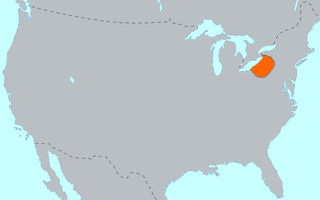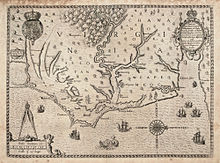
The Tuscarora are a Native American tribe and First Nations band government of the Iroquoian family, with members today in New York, USA, and Ontario, Canada. They coalesced as a people around the Great Lakes, likely about the same time as the rise of the Five Nations of the historic Iroquois Confederacy, also Iroquoian-speaking and based then in present-day New York.

The Tuscarora War was fought in North Carolina from September 10, 1711, until February 11, 1715, between the Tuscarora people and their allies on one side and European American settlers, the Yamasee, and other allies on the other. This was considered the bloodiest colonial war in North Carolina. The Tuscarora signed a treaty with colonial officials in 1718 and settled on a reserved tract of land in Bertie County, North Carolina. The war incited further conflict on the part of the Tuscarora and led to changes in the slave trade of North and South Carolina.

The Pamlico were American Indians of North Carolina. They spoke an Algonquian language also known as Pamlico or Carolina Algonquian.
The Cape Fear Indians were a small, coastal tribe of Native Americans who lived on the Cape Fear River in North Carolina.

The Erie people were Indigenous people historically living on the south shore of Lake Erie. An Iroquoian group, they lived in what is now western New York, northwestern Pennsylvania, and northern Ohio before 1658. Their nation was decimated in the mid-17th century by five years of prolonged warfare with the powerful neighboring Iroquois for helping the Huron in the Beaver Wars for control of the fur trade.

The Meherrin people are an Indigenous people of the Northeastern Woodlands, who spoke an Iroquian language. They lived between the Piedmont and coastal plains at the border of Virginia and North Carolina.

The Pee Dee people, also Pedee and Peedee, are American Indians of the Southeast United States. Historically, their population has been concentrated in the Piedmont of present-day South Carolina. In the 17th and 18th centuries, English colonists named the Pee Dee River and the Pee Dee region of South Carolina for the tribe.
The Machapunga were a small Algonquian language–speaking Native American tribe from coastal northeastern North Carolina. They were part of the Secotan people. They were a group from the Powhatan Confederacy who migrated from present-day Virginia.

The Piscataway Indian Nation, also called Piscatawa, is a state-recognized tribe in Maryland that is descended from the historic Piscataway people. At the time of European encounter, the Piscataway was one of the most populous and powerful Native polities of the Chesapeake Bay region, with a territory on the north side of the Potomac River. By the early seventeenth century, the Piscataway had come to exercise hegemony over other Algonquian-speaking Native American groups on the north bank of the river. The Piscataway nation declined dramatically before the nineteenth century, under the influence of colonization, infectious disease, and intertribal and colonial warfare.

Waccamaw Siouan Indians are one of eight state-recognized tribes in North Carolina. They are also known as the "People of the Fallen Star." Historically Siouan-speaking, they are located predominantly in the southeastern North Carolina counties of Bladen and Columbus. Their congressional representative introduced a failed bill for federal recognition in 1948. North Carolina recognized the group in 1971.

The Inner Banks is a neologism made up by developers and tourism promoters to describe the inland coastal region of eastern North Carolina. Without historical precedent, the term "Inner Banks" is an early 21st-century construct that is part of an attempt to rebrand the mostly agrarian coastal plain east of I-95 as a more attractive region for visitors and retirees.

The Cusabo or Cosabo were a group of American Indian tribes who lived along the coast of the Atlantic Ocean in what is now South Carolina, approximately between present-day Charleston and south to the Savannah River, at the time of European colonization. English colonists often referred to them as one of the Settlement Indians of South Carolina, tribes who "settled" among the colonists.
The Waxhaw people were a tribe native to what are now the counties of Lancaster, in South Carolina; and Union and Mecklenburg in North Carolina, around the area of present-day Charlotte. The Waxhaw were related to other nearby Southeastern peoples, such as the Catawba people and the Sugeree. It is speculated that they were culturally influenced by the Mississippian culture.

The Nottoway are an Iroquoian Native American tribe in Virginia. The Nottoway spoke a Nottoway language in the Iroquoian language family.

The Chowanoc, also Chowanoke, were an Algonquian-speaking Native American tribe who historically lived near the Chowan River in North Carolina.

The Doeg were a Native American people who lived in Virginia. They spoke an Algonquian language and may have been a branch of the Nanticoke tribe, historically based on the Eastern Shore of Maryland. The Nanticoke considered the Algonquian Lenape as "grandfathers". The Doeg are known for a raid in July 1675 that contributed to colonists' uprising in Bacon's Rebellion.
Francisco de Chicora was the baptismal name given to a Native American kidnapped in 1521, along with 70 others, from near Winyah Bay by Spanish explorer Francisco Gordillo and slave trader Pedro de Quexos, based in Santo Domingo and the first Europeans to reach the area. From analysis of the account by Peter Martyr, court chronicler, the ethnographer John R. Swanton believed that Chicora was from a Catawban group.

The Secotans were one of several groups of American Indians dominant in the Carolina sound region, between 1584 and 1590, with which English colonists had varying degrees of contact. Secotan villages included the Secotan, Aquascogoc, Dasamongueponke, Pomeiock (Pamlico) and Roanoac. Other local groups included the Chowanoke, Weapemeoc, Chesapeake, Ponouike, Neusiok, and Mangoak (Tuscarora), and all resided along the banks of the Albemarle and Pamlico sounds. They spoke Carolina Algonquian language, an Eastern Algonquian language.

The Neusiok were an Indigenous people of the Southeastern Wooodlands in present-day North Carolina. They were also known as the Neuse Indians.
The Hatteras Indians were a tribe of Native Americans in the United States who lived in the North Carolina Outer Banks. They inhabited a village on what is now called Hatteras Island called Croatoan.














